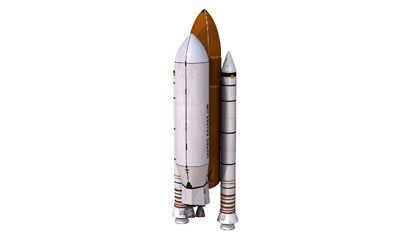How to build a Shuttle-derived heavy-lift programby Edward Ellegood
|
| Without a Shuttle-class rocket, billions of dollars in taxpayer-funded infrastructure will go unused, and thousands of uniquely skilled workers will be forced to pursue other careers. |
The course we’re now on seems consistent with the “Flexible Path” scenarios that were favored by the Augustine Committee, except for one small detail: how and when will we send humans to explore beyond Low Earth Orbit? The answer to this question may be revealed in upcoming news conferences or budget documents, but the posturing we’ve seen over the past week indicates that a new heavy-lift rocket program may not be part of NASA’s near-term future.
That’s a big problem for Florida and other states tied to the Space Shuttle program. Clearly, a new heavy-lift rocket program is needed for the kind of human exploration envisioned by the Augustine Committee. Without a Shuttle-class rocket, billions of dollars in taxpayer-funded infrastructure will go unused, and thousands of uniquely skilled workers will be forced to pursue other careers.
Of course, President Obama’s new direction for NASA will be debated vigorously in Congress, and members from Florida and other states are already calling for additional Shuttle missions to minimize the inevitable gap. They should also focus on ensuring that a Shuttle-derived heavy-lift rocket is among NASA’s near-term priorities. Senator Nelson Bill Nelson and Rep. Suzanne Kosmas are already heading in this direction.
I believe we now have an opportunity to re-shuffle the political deck to support such an initiative. In late October, elected officials from Alabama, Florida, Louisiana and Mississippi joined together to establish the Aerospace Alliance, described as a “private/public organization that will establish the Gulf Coast and surrounding region as a world class aerospace, space and aviation corridor.”
Despite its broadly described mission, the Alliance was formed first and foremost to support Northrop Grumman’s pursuit of the Air Force’s multi-billion-dollar KC-45 aerial tanker program, which would spread high-paying manufacturing jobs among the participating states. The need for a Shuttle-derived heavy-lift rocket can give this Alliance an additional high-profile purpose, and an opportunity to establish a powerful voting bloc in support of a single common-interest issue.
As homes to major NASA facilities (Kennedy, Marshall, Stennis, and Michoud) each of the Alliance’s member states is heavily invested in the Space Shuttle program and would benefit significantly from a Shuttle-derived development program. Add Texas and Johnson Space Center to the Alliance and it would include nearly half of NASA’s centers, and a clear majority of those responsible for human spaceflight. Consider the influence that a “Gulf States Aerospace Alliance” would have with five governors, 10 US Senators, and 75 Congressmen—not to mention 85 Electoral College votes—if they decided to work together on a single issue.
